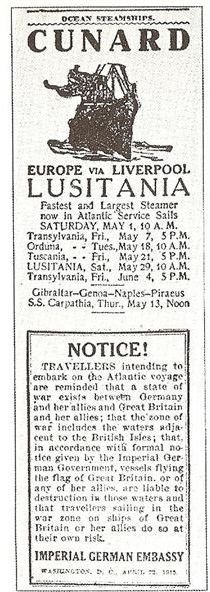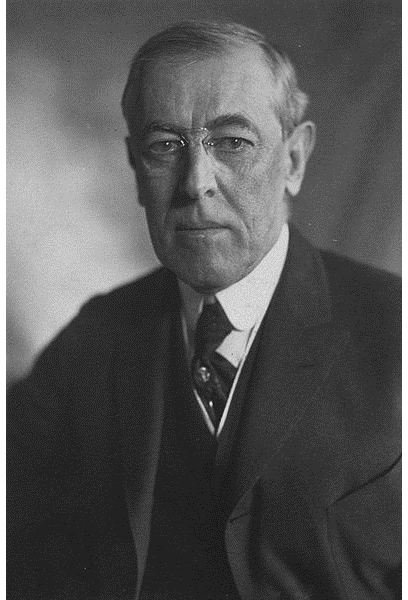High School Social Studies Unit for World War I - A Series of Five Lesson Plans
A World War I Unit
These five lessons are intended to focus on American involvement in World War I. They are written with a high school audience in mind. While they are based on my experience with an 88-minute class, modifying them to fit a traditional, shorter period should not be a problem.
When I teach this topic, I generally have students read the appropriate chapter in their textbook. However you choose to organize textbook reading, it should be finished by the fourth lesson in this series.
Lesson One: Background Information/Prelude to War
Bell Activity: (to be done by students at the beginning of class) Distribute copies of Wilfred Owen’s poem Dulce et Decorum Est, which can be found at Emory University’s website. Have students read the poem and then journal what they believe Owen is trying to convey about his experiences during World War I.
Map Exercise: Distribute a blank map of Europe and a map of Africa in 1914. Have students fill in as many countries as they can for the blank European map. Some students will notice that there are countries on this map that no longer exist (like Austria-Hungary). Help them finish filling out their maps and talk about the economic and military competition that was going on in Europe on the eve of war. Illustrate the point with the African map, pointing out how much of the continent had been colonized at this point. Describe the series of military alliances that had arisen by 1914. Triple Entente: England - France - Russia Central Powers: Germany - Austria-Hungary - Ottoman Empire.
Primary Source Reading: Print the speech by Navy War College founder Alfred Thayer Mahan, “The United States Looking Outward.” Depending upon the level of readers in your class, use as much of the speech as you think they can digest.
Ask students what they take away from the reading. Discuss the industrial, financial, and military growth of the United States after the Civil War. Mention the growth of the navy under Mahan and Benjamin Tracy, the rise of imperialism, the Spanish-American War, the Monroe Doctrine, and the Roosevelt Corollary.
Homework: Have students find definitions for the following vocabulary terms. Most of these can be found in any U.S. History textbook. Adapt as needed.
1. Woodrow Wilson
2. Doughboys
3. Zimmerman Telegram
4. Submarine warfare
5. Battle of Belleau Wood
6. Imperialism
7. “Over There”
8. General John J. Pershing
9. Vladimir Lenin
10. CPI
11. Sedition Act
12. Wilson’s 14 Points
13. Henry Cabot Lodge
14. Sergeant Alvin York
15. WPB
Lesson Two: The Road to War
Bell Activity: Write the following question on the board: “What would it take for the United States to join an expensive, dangerous war that was fought entirely in a different part of the world?” Have students journal their responses. Check student homework from previous night while students are writing. Announce vocabulary quiz for tomorrow.
Lecture: Remind students of the series of alliances that had developed in Europe prior to the war and the competition for colonies, markets, and raw materials. Explain the assassination of Archduke Franz Ferdinand in Sarajevo and how a “local” war turned into a “world” war.
Images: Either make overheads, use a computer projector, or make copies of the following images:

Ask students what they can tell about the fighting in World War I from these images. Draw out the concepts of the massive scale, damage, and immobility.
Jigsaw: Divide class into three groups and assign each group a reading.
- Have the first group read the German warning to Americans traveling to Europe (picture to the right; click to enlarge);
- the second Woodrow Wilson’s speech on u-boat warfare;
- and the third the text of the Zimmerman Telegram
Lesson Three: The War at Home
NOTE: Part of this lesson requires a classroom computer with speakers and sound capabilities.
Bell Activity: Write the question on the board: “Why in the end did the United States abandon neutrality and join World War I?” Have students journal their answer. Remind them that their textbook assignment for this chapter must be finished for tomorrow.
Assessment: Vocabulary quiz on terms from first day. Can be in any desired format.
Popular Songs: Give your students the lyrics to “Keep the Home Fires Burning” and “Over There”. Then, use your classroom computer to play each song and have students follow along. Songs can be found on InternetArchives.org, Sounds of War. Discuss what the songs reveal about the mood of the country upon America’s entry into the war.
Reading: Have students read the texts of the Selective Service Act of 1917 and the Sedition Act of 1918. Discuss the various ways in which the federal government approached the war at home, including the draft, persecuting opponents of the war, and organizing the WPB.
Finally, read the first three pages of this account describing the lynching of Robert Prager. Discuss the public backlash against German-Americans.
Homework: Have students bring in three essay-style questions that they have created about their textbook reading for tomorrow. Questions must begin with the words “explain”, “describe”, or “evaluate”.
Lesson Four: Contributions in Europe
NOTE: If you plan on doing Lesson Five tomorrow, read it now to see if you will need to reserve a computer lab today. Some schools require the lab reservation to be done in advance.
Bell Activity: Write the following question on the board: “What was America’s greatest contribution towards winning World War I?” Have students journal their answer. Remind students of the impending unit test, which should come after the fifth lesson. Check homework.
Socratic Seminar: Use the homework questions to run a Socratic Seminar.
Consider these thoughts:
- Assign people to your interior groups so that each one has some students who are naturally verbal and outgoing, if you can.
- Endure some uncomfortable silences. Students will surprise you if you let them.
- Resist the urge to answer questions.
- Don’t be afraid to let this activity stretch out. I have done some of these that lasted 45 minutes and had some of their best dialogue in the last five minutes.
Reading: “War and Revolution” by Vladimir Lenin, found at Marxists.org. You can use as much of this as you think your students can handle, but the first three paragraphs are all that are absolutely necessary. Use the reading to illustrate the thinking behind the Russian Revolution and the long-term implications of that event.
Lecture: Outline the military contributions of the American Expeditionary Force in Germany. Be certain to touch upon General Pershing’s insistence upon utilizing the Americans as a unified force, the size and condition of those fresh American troops, the battle at Belleau Wood, the story of Corporal Alvin York, and the eventual armistice.
Lesson Five: Outcomes of World War I
Bell Activity: Write the following question on the board: “Did the United States get what it wanted out of the victory in World War I?” Have students journal their responses.
Reading: Woodrow Wilson on moral diplomacy. Make sure that you highlight Wilson’s relative inexperience in foreign affairs and his reluctance to join the war until forced to.
After students have finished the reading, describe the gathering at Versailles to create peace and the vengeful attitude brought there by the British and French.
Document Analysis: Have students analyze Wilson’s 14 Points in pairs. Require them to “translate” each point to be sure that they understand them. Then, have them use an outside resource (could be their textbook or the internet) to determine which of the points came to pass.
Lecture: Outcomes of the war. Make sure that you highlight the failure of the United States to join the League of Nations and the ensuing impotence of that organization, the retreat of the United States into isolationism, the Great Migration, and the increasingly close relationship between the federal government and big business.
References
- Photo of Woodrow Wilson in the Public Domain via Wikimedia Commons
